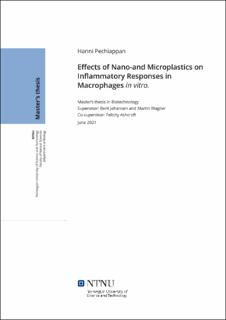| dc.description.abstract | Humans can be exposed to nano-and microplastics (NMP’s) via diet, inhalation, and possibly dermal routes, but the risk of such exposure to human health is unclear. Phagocytes are possible targets of NMP’s exposure, with the potential to impact human health. Thus, the aim of this thesis was to assess if NMP exposure leads to the inflammatory activation of monocytes and macrophages. To do this, we used polydisperse secondary NMPs: polymethyl methacrylate (PMMA), polystyrene (PS), and polyvinylchloride (PVC) generated from different sources and the THP-1 cell line, undifferentiated and differentiated as a substitute for primary monocytes, and macrophages respectively.
We assessed the cytotoxicity of the NMPs in monocytes and macrophages using viability assays. After 72 h of exposure at the highest particle concentration, all three NMPs reduced the macrophage viability, whereas monocyte viability was only affected by PS. The internalization of NMP’s by macrophages was determined using confocal microscopy, and we demonstrated the uptake of all three NMP types as early as 30 min after exposure. To assess pro-inflammatory responses in macrophages, we measured NF-κB translocation, expression of genes associated with M1 polarization (CCL2, TNFα, IL-12), and released cytokine levels (TNFα, IL-6). While stimulation with the known pro-inflammatory stimulus lipopolysaccharide (LPS) triggered NF-κB translocation, M1 macrophage polarization, and the release of TNFα and IL-6, none of the NMPs did, when given at the highest concentration for equivalent or longer time period. Exposure to NMP’s during M1 macrophage polarization using IFNγ + LPS, however, suppressed TNFα release, and during M1 polarization using IFNγ alone, suppressed both TNFα and IL-6 release. In monocytes similar to macrophages, we did not observe an increase in TNFα or IL-6 in response to NMPs alone, but the exposure during LPS-stimulation suppressed TNFα and IL-6 release.
In summary, we showed that the NMP's tested were internalized by THP-1 derived macrophages yet did not trigger pro-inflammatory responses. Exposure to NMP's during pro-inflammatory stimulation of macrophages or monocytes instead inhibited cytokine release, and we thus conclude that, in certain situations, NMP's exposure could suppress immune cell activation. Given that our results in THP-1 cells contradict the effects shown in primary immune cells, the findings should be used with caution. However, the potential for NMP's to suppress immune cell activation merits further investigation. | |
